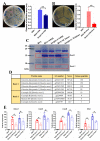Serpin-4 Negatively Regulates Prophenoloxidase Activation and Antimicrobial Peptide Synthesis in the Silkworm, Bombyx mori
- PMID: 38203484
- PMCID: PMC10778760
- DOI: 10.3390/ijms25010313
Serpin-4 Negatively Regulates Prophenoloxidase Activation and Antimicrobial Peptide Synthesis in the Silkworm, Bombyx mori
Abstract
The prophenoloxidase (PPO) activation and Toll antimicrobial peptide synthesis pathways are two critical immune responses in the insect immune system. The activation of these pathways is mediated by the cascade of serine proteases, which is negatively regulated by serpins. In this study, we identified a typical serpin, BmSerpin-4, in silkworms, whose expression was dramatically up-regulated in the fat body and hemocytes after bacterial infections. The pre-injection of recombinant BmSerpin-4 remarkably decreased the antibacterial activity of the hemolymph and the expression of the antimicrobial peptides (AMPs) gloverin-3, cecropin-D, cecropin-E, and moricin in the fat body under Micrococcus luteus and Yersinia pseudotuberculosis serotype O: 3 (YP III) infection. Meanwhile, the inhibition of systemic melanization, PO activity, and PPO activation by BmSerpin-4 was also observed. Hemolymph proteinase 1 (HP1), serine protease 2 (SP2), HP6, and SP21 were predicted as the candidate target serine proteases for BmSerpin-4 through the analysis of residues adjacent to the scissile bond and comparisons of orthologous genes in Manduca sexta. This suggests that HP1, SP2, HP6, and SP21 might be essential in the activation of the serine protease cascade in both the Toll and PPO pathways in silkworms. Our study provided a comprehensive characterization of BmSerpin-4 and clues for the further dissection of silkworm PPO and Toll activation signaling.
Keywords: Bombyx mori; antimicrobial peptide; immune system; prophenoloxidase; serpin.
Conflict of interest statement
The authors declare no conflicts of interest.
Figures








Similar articles
-
Serpin-5 regulates prophenoloxidase activation and antimicrobial peptide pathways in the silkworm, Bombyx mori.Insect Biochem Mol Biol. 2016 Jun;73:27-37. doi: 10.1016/j.ibmb.2016.04.003. Epub 2016 Apr 12. Insect Biochem Mol Biol. 2016. PMID: 27084699
-
Serpin-15 from Bombyx mori inhibits prophenoloxidase activation and expression of antimicrobial peptides.Dev Comp Immunol. 2015 Jul;51(1):22-8. doi: 10.1016/j.dci.2015.02.013. Epub 2015 Feb 23. Dev Comp Immunol. 2015. PMID: 25720980
-
Manduca sexta serpin-5 regulates prophenoloxidase activation and the Toll signaling pathway by inhibiting hemolymph proteinase HP6.Insect Biochem Mol Biol. 2010 Sep;40(9):683-9. doi: 10.1016/j.ibmb.2010.07.001. Epub 2010 Jul 17. Insect Biochem Mol Biol. 2010. PMID: 20624461 Free PMC article.
-
Innate immune responses of a lepidopteran insect, Manduca sexta.Immunol Rev. 2004 Apr;198:97-105. doi: 10.1111/j.0105-2896.2004.0121.x. Immunol Rev. 2004. PMID: 15199957 Review.
-
Antimicrobial peptides from Bombyx mori: a splendid immune defense response in silkworms.RSC Adv. 2020 Jan 2;10(1):512-523. doi: 10.1039/c9ra06864c. eCollection 2019 Dec 20. RSC Adv. 2020. PMID: 35492565 Free PMC article. Review.
Cited by
-
Characterization of temporal expression of immune genes in female locust challenged by fungal pathogen, Aspergillus sp.Front Immunol. 2025 Apr 28;16:1565964. doi: 10.3389/fimmu.2025.1565964. eCollection 2025. Front Immunol. 2025. PMID: 40356898 Free PMC article.
-
Enhancing the Survival of Ichneumonid Parasitoid Campoletis chlorideae (Hymenoptera: Ichneumonidae) by Utilizing Haserpin-e Protein to Effectively Manage Lepidopteran Pests.Insects. 2025 Apr 29;16(5):474. doi: 10.3390/insects16050474. Insects. 2025. PMID: 40429187 Free PMC article.
-
BmToll9-1 Is a Positive Regulator of the Immune Response in the Silkworm Bombyx mori.Insects. 2024 Aug 27;15(9):643. doi: 10.3390/insects15090643. Insects. 2024. PMID: 39336611 Free PMC article.
-
Innate Immunity in Insects: The Lights and Shadows of Phenoloxidase System Activation.Int J Mol Sci. 2025 Feb 4;26(3):1320. doi: 10.3390/ijms26031320. Int J Mol Sci. 2025. PMID: 39941087 Free PMC article. Review.
-
Unveiling the Multifaceted Role of HP6: A Critical Regulator of Humoral Immunity in Antheraea pernyi (Lepidoptera: Saturniidae).Int J Mol Sci. 2025 May 9;26(10):4514. doi: 10.3390/ijms26104514. Int J Mol Sci. 2025. PMID: 40429662 Free PMC article.
References
MeSH terms
Substances
Grants and funding
- 32200391, 32300403/National Natural Science Foundation of China
- 202103021223125, 202203021212469/Natural Science Foundation of Shanxi Province
- 2023YQPYGC05/the Distinguished and Excellent Young Scholar Cultivation Project of Shanxi Agricultural University
- 2020BQ71, 2022BQ25/Science and Technology Innovation Foundation of Shanxi Agricultural University
LinkOut - more resources
Full Text Sources

